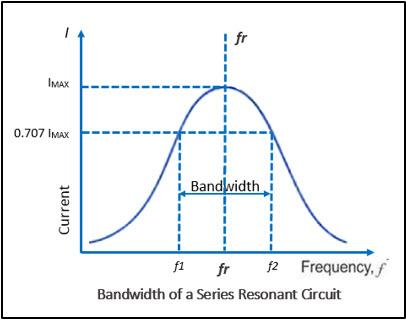
What is meant by half-power point frequencies? Obtain an expression for bandwidth in a LCR series circuit. Show half power point frequencies in a curve between alternating current and frequency.
Answer
574.2k+ views
Hint: Bandwidth is the difference in the half power frequencies. To obtain an expression for bandwidth, find the values of the half power frequencies. Find the current when the power is half of the maximum in terms of the maximum current. Use $V={{i}_{\max }}R$ and ${{Z}^{2}}={{R}^{2}}+{{\left( 2\pi fL-\dfrac{1}{2\pi fC} \right)}^{2}}$.
Formula used:
$V={{i}_{\max }}R$
${{Z}^{2}}={{R}^{2}}+{{\left( 2\pi fL-\dfrac{1}{2\pi fC} \right)}^{2}}$
Complete answer:
Half power points frequencies for a given LCR are the frequencies for which the power in the circuit is half of the maximum power in the circuit.
The current in the circuit at maximum power is also maximum. Let it be ${{i}_{max}}$.
Maximum current is obtained at resonance. At resonance, the frequency of the circuit is called resonance frequency (${{f}_{0}}$).
Every circuit has two half power frequencies ${{f}_{1}}$ and ${{f}_{2}}$.
The impedance of the circuit is Z=R.
Therefore, at resonance$V={{i}_{\max }}R$.
$\Rightarrow {{i}_{\max }}=\dfrac{V}{R}$ …. (i).
And the power is ${{P}_{max}}=i_{\max }^{2}R$
At the half frequencies, power of the circuit is $P=\dfrac{{{P}_{max}}}{2}=\dfrac{i_{\max }^{2}R}{2}={{\left( \dfrac{{{i}_{\max }}}{\sqrt{2}} \right)}^{2}}R$.
This means that the current in the circuit at half power frequencies is $\dfrac{{{i}_{\max }}}{\sqrt{2}}$.
Then, $V=\dfrac{{{i}_{\max }}}{\sqrt{2}}Z$.
Substitute the value of ${{i}_{max}}$ from (i).
$\Rightarrow V=\dfrac{\left( \dfrac{V}{R} \right)}{\sqrt{2}}Z$
$\Rightarrow \sqrt{2}R=Z$
$\Rightarrow 2{{R}^{2}}={{Z}^{2}}$
But, ${{Z}^{2}}={{R}^{2}}+{{\left( 2\pi fL-\dfrac{1}{2\pi fC} \right)}^{2}}$
Therefore,
$\Rightarrow 2{{R}^{2}}={{R}^{2}}+{{\left( 2\pi fL-\dfrac{1}{2\pi fC} \right)}^{2}}$
$\Rightarrow {{R}^{2}}={{\left( 2\pi fL-\dfrac{1}{2\pi fC} \right)}^{2}}$
$\Rightarrow R=\pm \left( 2\pi fL-\dfrac{1}{2\pi fC} \right)$
This proves that there are two values of half power frequencies.
Therefore,
$R=2\pi {{f}_{1}}L-\dfrac{1}{2\pi {{f}_{1}}C}$ or $R=\dfrac{1}{2\pi {{f}_{2}}C}-2\pi {{f}_{2}}L$.
$\Rightarrow R=\dfrac{4{{\pi }^{2}}f_{1}^{2}LC-1}{2\pi {{f}_{1}}C}$
$\Rightarrow 2\pi {{f}_{1}}CR=4{{\pi }^{2}}f_{1}^{2}LC-1$ ….. (iii).
And
$\Rightarrow R=\dfrac{1-4{{\pi }^{2}}f_{2}^{2}LC}{2\pi {{f}_{2}}C}$
$\Rightarrow 2\pi {{f}_{2}}CR=1-4{{\pi }^{2}}f_{2}^{2}LC$ ….. (iv).
Add (iii) and (iv).
$\Rightarrow 2\pi {{f}_{1}}CR+2\pi {{f}_{2}}CR=4{{\pi }^{2}}f_{1}^{2}LC-1+1-4{{\pi }^{2}}f_{2}^{2}LC$
$\Rightarrow \left( {{f}_{1}}+{{f}_{2}} \right)R=2\pi \left( f_{1}^{2}-f_{2}^{2} \right)L$
$\Rightarrow \left( {{f}_{1}}+{{f}_{2}} \right)R=2\pi \left( {{f}_{1}}+{{f}_{2}} \right)\left( {{f}_{1}}-{{f}_{2}} \right)L$
$\Rightarrow \left( {{f}_{1}}-{{f}_{2}} \right)=\dfrac{R}{2\pi L}$.
The difference in the half power frequencies i.e. $\left( {{f}_{1}}-{{f}_{2}} \right)$, is called bandwidth.
Therefore, we found an expression for the bandwidth.
The curve of alternating current with respect to the frequency of the source is shown below.

Note:
The value of bandwidth can also be found if we know the expression for the quality factor (Q) of a given circuit. The quality factor is defined as $Q=\dfrac{{{f}_{0}}}{BW}$, ${{f}_{0}}$ is the resonance frequency of the LCR circuit and BW is the bandwidth of the circuit.
The quality factor is also given as $Q=\dfrac{2\pi {{f}_{0}}L}{R}$.
$\Rightarrow Q=\dfrac{{{f}_{0}}}{BW}=\dfrac{2\pi {{f}_{0}}L}{R}$
$\Rightarrow \dfrac{1}{BW}=\dfrac{2\pi L}{R}$
$\Rightarrow BW=\dfrac{R}{2\pi L}$.
Formula used:
$V={{i}_{\max }}R$
${{Z}^{2}}={{R}^{2}}+{{\left( 2\pi fL-\dfrac{1}{2\pi fC} \right)}^{2}}$
Complete answer:
Half power points frequencies for a given LCR are the frequencies for which the power in the circuit is half of the maximum power in the circuit.
The current in the circuit at maximum power is also maximum. Let it be ${{i}_{max}}$.
Maximum current is obtained at resonance. At resonance, the frequency of the circuit is called resonance frequency (${{f}_{0}}$).
Every circuit has two half power frequencies ${{f}_{1}}$ and ${{f}_{2}}$.
The impedance of the circuit is Z=R.
Therefore, at resonance$V={{i}_{\max }}R$.
$\Rightarrow {{i}_{\max }}=\dfrac{V}{R}$ …. (i).
And the power is ${{P}_{max}}=i_{\max }^{2}R$
At the half frequencies, power of the circuit is $P=\dfrac{{{P}_{max}}}{2}=\dfrac{i_{\max }^{2}R}{2}={{\left( \dfrac{{{i}_{\max }}}{\sqrt{2}} \right)}^{2}}R$.
This means that the current in the circuit at half power frequencies is $\dfrac{{{i}_{\max }}}{\sqrt{2}}$.
Then, $V=\dfrac{{{i}_{\max }}}{\sqrt{2}}Z$.
Substitute the value of ${{i}_{max}}$ from (i).
$\Rightarrow V=\dfrac{\left( \dfrac{V}{R} \right)}{\sqrt{2}}Z$
$\Rightarrow \sqrt{2}R=Z$
$\Rightarrow 2{{R}^{2}}={{Z}^{2}}$
But, ${{Z}^{2}}={{R}^{2}}+{{\left( 2\pi fL-\dfrac{1}{2\pi fC} \right)}^{2}}$
Therefore,
$\Rightarrow 2{{R}^{2}}={{R}^{2}}+{{\left( 2\pi fL-\dfrac{1}{2\pi fC} \right)}^{2}}$
$\Rightarrow {{R}^{2}}={{\left( 2\pi fL-\dfrac{1}{2\pi fC} \right)}^{2}}$
$\Rightarrow R=\pm \left( 2\pi fL-\dfrac{1}{2\pi fC} \right)$
This proves that there are two values of half power frequencies.
Therefore,
$R=2\pi {{f}_{1}}L-\dfrac{1}{2\pi {{f}_{1}}C}$ or $R=\dfrac{1}{2\pi {{f}_{2}}C}-2\pi {{f}_{2}}L$.
$\Rightarrow R=\dfrac{4{{\pi }^{2}}f_{1}^{2}LC-1}{2\pi {{f}_{1}}C}$
$\Rightarrow 2\pi {{f}_{1}}CR=4{{\pi }^{2}}f_{1}^{2}LC-1$ ….. (iii).
And
$\Rightarrow R=\dfrac{1-4{{\pi }^{2}}f_{2}^{2}LC}{2\pi {{f}_{2}}C}$
$\Rightarrow 2\pi {{f}_{2}}CR=1-4{{\pi }^{2}}f_{2}^{2}LC$ ….. (iv).
Add (iii) and (iv).
$\Rightarrow 2\pi {{f}_{1}}CR+2\pi {{f}_{2}}CR=4{{\pi }^{2}}f_{1}^{2}LC-1+1-4{{\pi }^{2}}f_{2}^{2}LC$
$\Rightarrow \left( {{f}_{1}}+{{f}_{2}} \right)R=2\pi \left( f_{1}^{2}-f_{2}^{2} \right)L$
$\Rightarrow \left( {{f}_{1}}+{{f}_{2}} \right)R=2\pi \left( {{f}_{1}}+{{f}_{2}} \right)\left( {{f}_{1}}-{{f}_{2}} \right)L$
$\Rightarrow \left( {{f}_{1}}-{{f}_{2}} \right)=\dfrac{R}{2\pi L}$.
The difference in the half power frequencies i.e. $\left( {{f}_{1}}-{{f}_{2}} \right)$, is called bandwidth.
Therefore, we found an expression for the bandwidth.
The curve of alternating current with respect to the frequency of the source is shown below.

Note:
The value of bandwidth can also be found if we know the expression for the quality factor (Q) of a given circuit. The quality factor is defined as $Q=\dfrac{{{f}_{0}}}{BW}$, ${{f}_{0}}$ is the resonance frequency of the LCR circuit and BW is the bandwidth of the circuit.
The quality factor is also given as $Q=\dfrac{2\pi {{f}_{0}}L}{R}$.
$\Rightarrow Q=\dfrac{{{f}_{0}}}{BW}=\dfrac{2\pi {{f}_{0}}L}{R}$
$\Rightarrow \dfrac{1}{BW}=\dfrac{2\pi L}{R}$
$\Rightarrow BW=\dfrac{R}{2\pi L}$.
Recently Updated Pages
A man running at a speed 5 ms is viewed in the side class 12 physics CBSE

The number of solutions in x in 02pi for which sqrt class 12 maths CBSE

State and explain Hardy Weinbergs Principle class 12 biology CBSE

Write any two methods of preparation of phenol Give class 12 chemistry CBSE

Which of the following statements is wrong a Amnion class 12 biology CBSE

Differentiate between action potential and resting class 12 biology CBSE

Trending doubts
What are the major means of transport Explain each class 12 social science CBSE

Which are the Top 10 Largest Countries of the World?

Draw a labelled sketch of the human eye class 12 physics CBSE

How much time does it take to bleed after eating p class 12 biology CBSE

Explain sex determination in humans with line diag class 12 biology CBSE

Explain sex determination in humans with the help of class 12 biology CBSE




